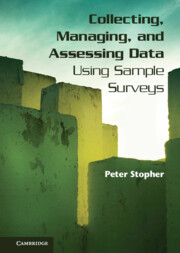Book contents
- Frontmatter
- Contents
- Figures
- Tables
- Acknowledgements
- 1 Introduction
- 2 Basic statistics and probability
- 3 Basic issues in surveys
- 4 Ethics of surveys of human populations
- 5 Designing a survey
- 6 Methods for conducting surveys of human populations
- 7 Focus groups
- 8 Design of survey instruments
- 9 Design of questions and question wording
- 10 Special issues for qualitative and preference surveys
- 11 Design of data collection procedures
- 12 Pilot surveys and pretests
- 13 Sample design and sampling
- 14 Repetitive surveys
- 15 Survey economics
- 16 Survey implementation
- 17 Web-based surveys
- 18 Coding and data entry
- 19 Data expansion and weighting
- 20 Nonresponse
- 21 Measuring data quality
- 22 Future directions in survey procedures
- 23 Documenting and archiving
- References
- Index
9 - Design of questions and question wording
Published online by Cambridge University Press: 05 June 2012
- Frontmatter
- Contents
- Figures
- Tables
- Acknowledgements
- 1 Introduction
- 2 Basic statistics and probability
- 3 Basic issues in surveys
- 4 Ethics of surveys of human populations
- 5 Designing a survey
- 6 Methods for conducting surveys of human populations
- 7 Focus groups
- 8 Design of survey instruments
- 9 Design of questions and question wording
- 10 Special issues for qualitative and preference surveys
- 11 Design of data collection procedures
- 12 Pilot surveys and pretests
- 13 Sample design and sampling
- 14 Repetitive surveys
- 15 Survey economics
- 16 Survey implementation
- 17 Web-based surveys
- 18 Coding and data entry
- 19 Data expansion and weighting
- 20 Nonresponse
- 21 Measuring data quality
- 22 Future directions in survey procedures
- 23 Documenting and archiving
- References
- Index
Summary
Introduction
Chapter 8 provides considerable information on the survey instrument design and offers many directions on how to accomplish a good design for both interviewer- administered and respondent-administered surveys. In this chapter, the specific issue of how to write questions in a survey is addressed. As with many of the topics covered in this book, there are entire books written on the topic of question wording and designing questions. This chapter provides an overall guide to the topic, as well as references to more in-depth treatment of certain topics.
The goal of writing questions in a survey is to have every respondent interpret the question exactly the same way, have every respondent be able to respond accurately to each question, and have every respondent willing to respond. This is not an easy task. Dillman (2000) illustrates how difficult this can be, by using as an example a question asked of students about the amount of time that they study each day. In one version of the survey, the respondents were asked to select a response from a set that began with less than half an hour, and had a maximum of more than 2.5 hours. In a second version, the response range was given as starting at less than 2.5 hours, and increasing to a maximum of more than 4.5 hours. In both response sets, the responses incremented by 0.5 hours, so that version one had categories of less than 0.5 hours, 0.5–1.0 hours, 1.0–1.5 hours, etc. In addition to this, the surveys were conducted by mail and by telephone for each version.
- Type
- Chapter
- Information
- Collecting, Managing, and Assessing Data Using Sample Surveys , pp. 177 - 198Publisher: Cambridge University PressPrint publication year: 2012



